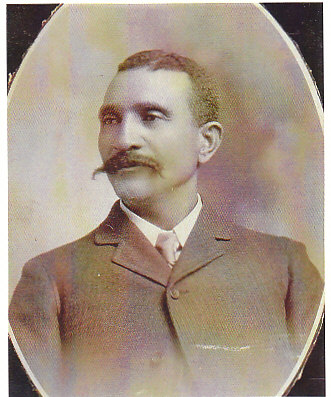by Kristine Schmucker, HCHM Curator
This post continues the story of Charles Schaefer of Sedgwick, Ks
This post continues the story of Charles Schaefer of Sedgwick, Ks
This past Monday, we celebrated President's Day. Most of us will never have the chance to meet the President of the United States, but one Kansan did. In later years, Schaefer recalled his experiences as a soldier in the capitol during which time he met President Lincoln.
In his handwritten notebook of remembrances, Schaefer related his impressions of President Abraham Lincoln.
"A very queer man. . . Personally there was much good about him which was alright in civil life, but in war was not good.* I met him face to face between the White House and Treasurery Building, stood at attentions and saluted as was proper. He certainly was the homeliest man I ever saw; stove pipe hat, big clothing that did not fit. But I gave him a square good look in the eyes and I do not believe I ever saw a kinder and sympathetic [person]. I rather pity him, he looked so lonesome and sorrowful. . . Of course, I saw him several times at Grand Reviews."In this faded clipping from an undated Wichita Eagle, Schaefer recalled an incident from the close of the Civil War related to the assassination of President Lincoln.
 |
| Newspaper clipping in the Schaefer Scrapbook Sedgwick Historical Society Sedgwick, Ks |
Schaefer was regimental quartermaster sergeant of the Third United States Infantry and he had been ordered to Washington D.C. at the close of the war. He was given rooms in the federal penitentiary while he worked to return supplies. It was during this time that he made the acquaintance of several sailors and they had a tale to tell him. He was pledged to the utmost secrecy and was told of the mysterious activities that the sailors had completed under orders.
"Eight sailors of the U.S. nave detailed to have charge of a boat kept in readiness for the governments use. . . . One night they had been called upon to take their boat and row upstream til they found a ship on the other side of the Potomac. . . . When the drew alongside the ship, they were stopped and a box, casket-shaped, was lowered into their boat and they were ordered to return to shore."
Schaefer continued to describe how the sailors were blindfolded and "marched around until they did not have the least idea where they were." The blindfolds were removed and they found themselves in a "large barren room with flagstone floor." The sailors were then ordered to remove the flagstone and dig a specific sized hole. The specifications they "noticed were the size of a grave. . . . they were ordered to place the box" from their boat in the hole. Next, they were to "replace the stone and remove all traces of the night's work." Once returned to their boat they were "dismissed with the order to keep their mouths shut."
The men were sure that they recognized the room as one in the Old Penitentiary and they were convinced that the body was that of John Wilkes Booth.
Schaefer concluded his story by noting:
Schaefer concluded his story by noting:
"I promised I would not repeat the information since they were under orders to keep still. I kept my word until this long distant date when telling can do no harm."
When I first read this story in the Schaefer Scrapbook I thought it was a 'tall tale', but a bit of research supported much of what Schaefer described. Booth was shot through the neck by Sergeant Boston Corbett on the porch of Richard Garrett's house near Port Royal, Virginia, where he died. The body was sewn up in a horse blanket and taken to Belle Plain where it was hoisted upon the deck of steamer John S Ide.
The body was delivered to the Montauk where an autopsy was performed April 27, 1865. Booth was identified by several people who had known him well, including Dr. John Frederick May. Dr. May had recently removed a large fibroid tumor from Booth's neck and the scar was still visible on the body. Booth's dentist also positively identified the body.
The Secretary of War Edwin Stanton ordered the body to be buried in the Old Penitentiary on the Washington Arsenal grounds - exactly where Shaefer was staying in 1865. This was accomplished.
 |
| John Wilkes Booth's Autopsyhttp://rogerjnorton.com/Lincoln83.html |
In 1869, the body was exhumed and positively identified and returned to the Booth family. Booth was buried in an unmarked grave in the family plot in Green Mount Cemetery, Baltimore on June 26, 1869.
Sources:
- Schaefer Scrapbook, Sedgwick Historical Society, Sedgwick, Ks
- http://rogerjnorton.com/Lincoln83.html;
For information on the mystery and legend that surrounds Booth's body visit: http://www.historybuff.com/library/refbooth.html;
*Schaefer had some very strong opinions about the dismissal of Union General McClellan. He noted that the General, known as " 'Little Mac' . . was too much the loyal soldier."
*Schaefer had some very strong opinions about the dismissal of Union General McClellan. He noted that the General, known as " 'Little Mac' . . was too much the loyal soldier."
Visit our web page for museum events - http://hchm.org/






